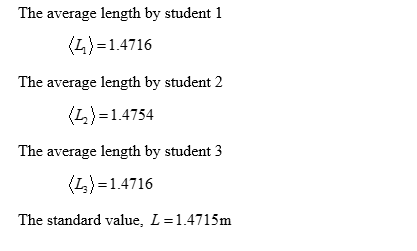Three students make measurements (in m) of the length of a rod using a meter stick. Each student's measurements are tabulated in the table below. Using your calculator in statistic mode calculate the mean L, standard deviation S and uncertainty u of the measurements.
Three students make measurements (in m) of the length of a rod using a meter stick. Each student's measurements are tabulated in the table below. Using your calculator in statistic mode calculate the mean L, standard deviation S and uncertainty u of the measurements.
College Physics
11th Edition
ISBN:9781305952300
Author:Raymond A. Serway, Chris Vuille
Publisher:Raymond A. Serway, Chris Vuille
Chapter1: Units, Trigonometry. And Vectors
Section: Chapter Questions
Problem 1CQ: Estimate the order of magnitude of the length, in meters, of each of the following; (a) a mouse, (b)...
Related questions
Concept explainers
Question
100%
Hello, based on a, b and c in the pictures, can you help me solve just d and e please?

Transcribed Image Text:3. Three students make measurements (in m) of the length of a rod using a meter stick. Each
student's measurements are tabulated in the table below. Using your calculator in statistic
mode calculate the mean L, standard deviation S and uncertainty u of the measurements.
Student L₁
Student 1
1.4717
Student 2
1.4753
Student 3 1.4719
L2
1.4711
1.4759
1.4723
L3
1.4722
1.4756
1.4705
L4
1.4715
1.4749
1.4719
ī
1.4716
11.4754
11.4716
SD
0.000397
u
± 0.000397
0.000 370 ± 0.000370
10.000685 ± 0.000685
Note that the actual length of the rod is determined by a laser measurement technique to be
1.4715 m (this should be considered the standard value).
a) State how one determines the accuracy of a measurement. Apply your idea to the
measurements of the three students above and state which student has the most
accurate measurement.
Three students make measurements (in m) of the length of a
rod using a meter stick.
Each student's measurements are tabulated in the table.
Using the calculator in statistic mode calculate the mean L,
standard deviations and uncertainty in of the measurements.

Transcribed Image Text:b) Do any of the three students have data that suggest the possibility of an error? If so,
state which student it is, and state how the data indicate your conclusion.
One determine the accuracy of a measurement by comparing practical value with standard volue,
and calculate relative error. theritor student I has close value near standard value and least
uncertainty so student has most accurate measurement.
there is a systematic error in the measurement when the measurement are close to jach other.
the standard value is 1.4715 and student a has a largest value 1.4754, so student a data
shows systematic error.
c) Which student has the best measurement considering both accuracy and precision?
State clearly what the characteristics are of the student's data on which your answer is
based.
accuracy is calculated as
student 1:
Precision is calculated:
student 1: 1.4722-1.4711
1.4716
x 100 =0.07
student 2: 1.4759-1.4749x 100 = 0·07
1.4754
student 3: 1.4723-1.4705x100 = 0.12
1.4716
student 2:
student 2
11.4715-1/14716 +100/1.41715-14754X100 1.4715-1.47161 x 100 most
1.4715
1-4716
1.4716
accurate
and
0.007
precision.
= 0.007
d) Calculate the percentage error between average length obtained by student I and the
standard value using formula (1).
-0.26
So, student
data has
ndard value
e) Calculate the percentage difference for average lengths obtained by students 1 and 3
using formula (2).
Expert Solution
Step 1: From the table,

Step by step
Solved in 3 steps with 2 images

Knowledge Booster
Learn more about
Need a deep-dive on the concept behind this application? Look no further. Learn more about this topic, physics and related others by exploring similar questions and additional content below.Recommended textbooks for you

College Physics
Physics
ISBN:
9781305952300
Author:
Raymond A. Serway, Chris Vuille
Publisher:
Cengage Learning

University Physics (14th Edition)
Physics
ISBN:
9780133969290
Author:
Hugh D. Young, Roger A. Freedman
Publisher:
PEARSON

Introduction To Quantum Mechanics
Physics
ISBN:
9781107189638
Author:
Griffiths, David J., Schroeter, Darrell F.
Publisher:
Cambridge University Press

College Physics
Physics
ISBN:
9781305952300
Author:
Raymond A. Serway, Chris Vuille
Publisher:
Cengage Learning

University Physics (14th Edition)
Physics
ISBN:
9780133969290
Author:
Hugh D. Young, Roger A. Freedman
Publisher:
PEARSON

Introduction To Quantum Mechanics
Physics
ISBN:
9781107189638
Author:
Griffiths, David J., Schroeter, Darrell F.
Publisher:
Cambridge University Press

Physics for Scientists and Engineers
Physics
ISBN:
9781337553278
Author:
Raymond A. Serway, John W. Jewett
Publisher:
Cengage Learning

Lecture- Tutorials for Introductory Astronomy
Physics
ISBN:
9780321820464
Author:
Edward E. Prather, Tim P. Slater, Jeff P. Adams, Gina Brissenden
Publisher:
Addison-Wesley

College Physics: A Strategic Approach (4th Editio…
Physics
ISBN:
9780134609034
Author:
Randall D. Knight (Professor Emeritus), Brian Jones, Stuart Field
Publisher:
PEARSON